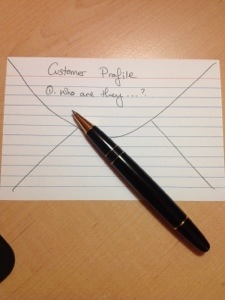If you’re a business owner doing your own content-marketing, or an organisation with employees adding content creation to their current roles, you’re constantly fighting a battle between quality and time.
You know you’re supposed to do in-depth customer profiles, and somewhere you’ve got one of those on file, it’s just quicker to get 5-10 quick blog posts rattled off and published.
However, this can lead to content that is “on-topic” but “off-target” and you might find yourself attracting readers who aren’t interested in ever being your customer.
So here is something to help.

Okay, next time you’re writing your content, grab a scrap of paper or envelope and complete the following quick profile. Then use your answers directly in your copy.
They key is to resist the temptation to dress up your answers when you write your content. Why? Well, when working with companies I find that if I ask them direct questions they give me absolute gold for answers.
But with the pressure of writing it down, flowery language soon strips away the impact.
Q: What do your customers like about working with you?
A: Companies love that we have an office in the country, but also have international links. They feel confident working on an international project with a team they can visit in-person.What’s written: Unlock your global potential when you partner with us.
The straight answer would be much more effective. This isn’t resume (CV) writing where a position as cafe worker in a leisure centre becomes “Hospitality executive within a recreational facility” (I used to tell children we’d run out of anything I didn’t know how to cook. So many disappointed little faces).
So – got your envelope? Then let’s go.
Who are you writing to?
Be specific. Don’t say “educational institutions” if you mean language centres and universities. If you mean more than one audience section, list them or use bullet points to make them stand out. Much better that your reader can identify specifically with one example, than wonder if they fit into a larger, generic group.
What do they want?
Again, try to think of something tangible that your audience wants. Something that can be measured. For example, more sales, more students in their class, more readers, more engagement online.
Avoid “better life” making “dreams a reality” (unless you’re DisneyWorld) and taking anything to the “next level.”
Saving time, saving money or a better night’s sleep are all good examples of results that can be measured.
Why do they want this?
When you can show your customer that you understand why they want to achieve their goals, you build credibility.
If you provide productivity training for mums, saying you understand that they want to leave work on time to spend more time with their family will be more effective than saying you understand they want to leave work on time so they can get ready and go out with the girls every night of the week (example for illustration purposes only).
Jot down 2-3 reasons they want to achieve their goals and remember to be direct and specific.
What worries them if they DON’T achieve this?
Flip the above point on its head. Appealing to someone’s worries or concerns can be very effective especially if it is a real worry. Take the above example, you might know a concern of your audience is missing out on their children growing up. That would be a valid point to include in your content.
What do they need to do before they can achieve their goal?
It’s worth noting down what their next steps are that help them move closer to achieving their goal. This is because each piece of content you create will appeal to your buyer at slightly different stages.
Let’s say your customer is planning a kitchen. You’re writing a brochure to help people with the planning stages. Remind yourself what your reader’s next steps are at this stage. They might not be ready to choose units just yet, because they might need advice on room sizes, and how many units can fit within that space. Or they might need to work out what their budget should be.
Having an idea what process your customers go through before they buy lets you create content that speaks to their needs at each stage.
How can you help them?
It’s easy to become so familiar with your product that you explain how life-changing your service is, without explaining the nuts and bolts of what it will help your customer do.
If you are a personal shopper, don’t just say that you will transform your customer’s fashion sense, explain HOW you will do this.
Breaking down the steps and showing how you work also builds proof that you’re not just making an empty promise but can do what you say.
What other methods could they use?
A common copywriting technique is to explain why your product or service is better suited to your customer than other methods and to do this, you need to be aware what else your customer could use to help them solve their problem.
For example, a programme that teaches you how to build and design a website quickly could be compared to the expense of hiring a design team, or the time-intensive process of doing it all yourself.
Why would they prefer working with you?
This can be a clear comparison to the methods you’ve outlined above, or it can be simple statement about what customers have said about working with you in the past. Do they like your friendly service? Do they like 24 hour support?
The reason this needs writing down is that you’ve probably thought about and talked about these things so often that they seem repetitive to you. They will be. But to your customer it could be the first time they’ve ever read your content, so don’t waste an opportunity to share why your current customers love working with you.
What do you do next?
Each time you write a blog post, article or leaflet, draft up a quick back-of-an-envelope customer profile. It takes minutes to do, but makes writing so much easier. Once it’s done, you can write your content, then glance at your customer profile and make sure you’re hitting as many points as possible.
Hopefully this has helped you create a quick but useful customer profile for your content marketing. Soon we’ll be looking in a bit more detail how you can create a more in-depth profile, and how you can use this in your content creation. Stay tuned!

[…] when we looked at creating back-of-the-envelope customer profiles for your content […]